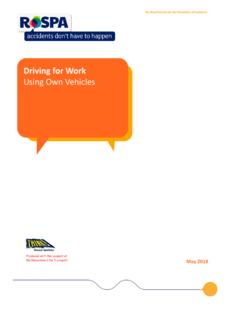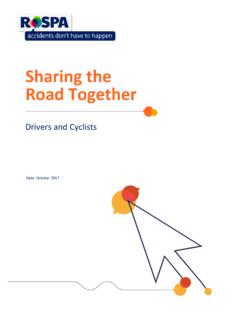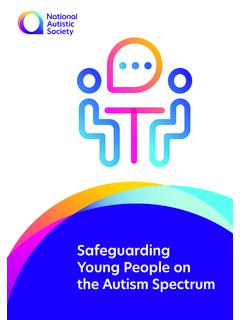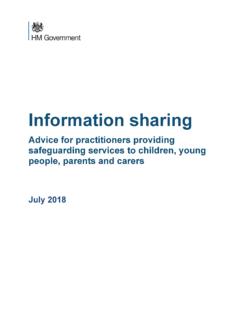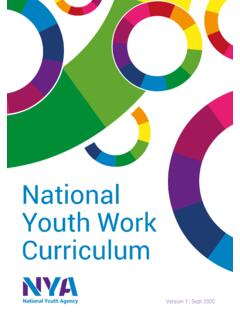Transcription of Teaching Road Safety: A Guide for Parents - RoSPA
1 Teaching road safety : A Guide for Parents Produced with the support of Department for Transport Teaching road safety : A Guide for Parents 2 Contents Introduction 3 Toddlers 4 children aged 5-7 5 children aged 8-11 9 young people aged 11-15 13 Teaching road safety : A Guide for Parents 3 Introduction road safety is a great subject in which to engage children and young people . It s a subject even the youngest children know something about because everyone uses the roads, whether driving, walking, or travelling as a passenger.
2 Unfortunately, this comes at a price, which includes people being killed and injured. However, road deaths and injuries are not inevitable. The last few decades have demonstrated that effective and comprehensive road safety strategies can reduce the number of people killed or injured on the road , despite increasing traffic. Walking and cycling to school are an important part of the government s active travel agenda and help build daily exercise into our lives, resulting in health and environmental benefits.
3 Parents and carers play an important role in preparing children to become independent travellers. This Guide provides advice on what age specific road safety information children should be taught and simple techniques for doing this. A survey commissioned by The Royal Society for the Prevention of Accidents ( RoSPA ) of Parents of primary school children found that less than half had received any road safety education training within the last 12 months in school, meaning that in many cases, road safety education becomes the responsibility of Parents .
4 For those children who did receive some road safety education it is still vital that Parents build on this, reinforce the learning and set a good example. Encouragingly, the survey also revealed that more than half of Parents felt that they were best placed to teach their child road safety skills. road safety is best taught in a practical setting meaning that Parents are ideally placed when walking their children to school to discuss road safety topics such as safe and dangerous places to cross the road .
5 children often mimic the behaviour of their Parents and carers, so it is vital to be consistent and put into practice safe crossing techniques. The Guide focuses primarily on Teaching these skills to children aged between 4 and 11, although there is some advice for younger and older children . Teaching road safety : A Guide for Parents 4 Toddlers When your child first starts to walk with you, talk to them about how they must always hold hands with a grown-up that they know, walking on the side of the pavement furthest away from traffic.
6 You should make sure that hand-holding is the number one rule that your child always follows when walking near the road . If your child is likely to pull away from you, it may be advisable to use safety reigns or a wrist strap. At this age, you will need to speak simply about road safety in a way that your child can understand. If you use words such as kerb, remember to explain what that is. Even at a very early age, you can explain how zebra and pedestrian crossings work. You can make pressing the button and waiting for the green man into a game.
7 Talk about bright and dull colours and which are best seen at night. You could also show your child clothing with reflective strips and how the material shines at night when a light is shone on it. Key messages Difference between footpath and the road How to walk with a grown-up who they know and hold hands near the road Introduce Stop, Look, Listen and Think Introduce safer crossing places Be bright be seen The Department for Transport has resources that you can use: Teaching road safety .
8 A Guide for Parents 5 children aged 5-7 (Key Stage 1) children are never too young to start learning about how to cross the road safely, how they should walk on the pavement and how to behave safely near the road and around traffic. They are more likely to learn when out on the road , rather than in a classroom or through talking about road safety at home. Bear in mind that younger children might not understand that different situations require different responses and behaviours. For example, if you do not stop at the kerb when crossing the road to search for traffic because it is clearly an empty road and continue directly into the road , your child may not understand that they need to actually look before stopping for the traffic.
9 At this age, children should always be accompanied by and hold hands with an adult they know around roads, particularly when they are crossing the road . Although the onus is on the motorist to look out for pedestrians, it can be difficult for motorists to see smaller children , particularly when reversing, so take extra care. Never let your child go near a road alone, even with an older child. If your hands are full, you can ask your child to hold onto your shopping bag or a pushchair handle. children at this age cannot accurately judge the speed of traffic and safe gaps in traffic in the way that adults can and should not be left unsupervised to cross even quiet roads alone.
10 Key messages How pedestrians walk safely on the pavement and vehicles use the road How to walk with an adult who they know and hold hands when walking near the road Safer crossing places and how to use them The Stop, Look, Listen and THINK sequence. How pedestrians walk on the pavement and vehicles travel on the road Places where it is not safe to cross the road , The Department for Transport has Teaching resources that you can use: Teaching road safety : A Guide for Parents 6 Driveway safety A key area of concern regarding children s road safety is surprisingly at the child s own home.


